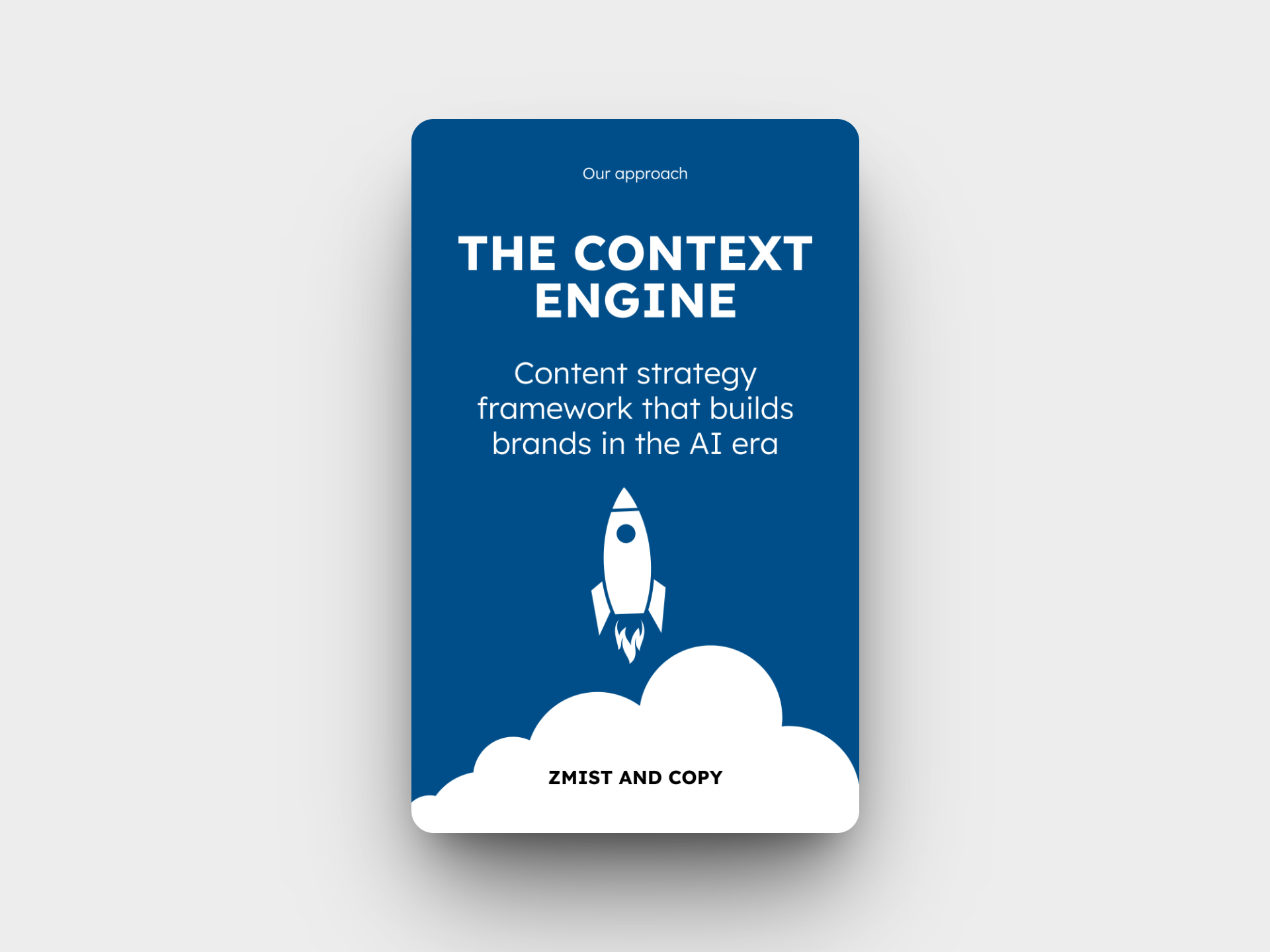The keyword-led content era is over. Google isn't the only gatekeeper anymore. People "search" in AI tools like ChatGPT, Perplexity, and Claude. To show up there, your content needs context.
But building context is harder than copying competitors or writing ultimate guides.
You need to know your audience.
You need to stand for something.
You need to be a brand.
Brand might not seem important, especially when it’s so easy to get quoted by AI.
Companies that write AI-generated content and pay for links are getting mentioned alongside companies with actual expertise.
We don't think it will last.
AI will need a way to prove where its knowledge comes from, and that it’s grounded in real human experience. Its own EEAT.
When that happens, AI tools will have to become selective. But until then, we're stuck in the spam acceleration phase.
This is why now is exactly when brand matters most.
When AI citations start favoring true expertise over SEO optimization, the companies that invested in distinctive positioning and authority will already be ahead. The ones still chasing keywords and trying to game the system will be left behind.
At Zmist & Copy, we developed The Context Engine. It's a three-part content framework built specifically for this transition.
It's how we help B2B tech companies build the kind of brand authority that survives algorithm changes, whether it's Google's updates or AI's evolution toward quality signals.
Ready to zmistify your content? Here's exactly how our Context Engine works.
TL;DR
- The Context Engine, a three-framework content strategy that builds brand authority
- Teach & Tilt (TOFU): Challenge industry assumptions and coin memorable frameworks
- See It Solved (MOFU): Show your product solving problems with specific examples
- Results-Forward (BOFU): Lead with outcomes in case studies that prove your claims
- Your Zmistification roadmap: what you need to do to start using our framework to create and distribute content that builds brand authority.
Part I: Why everything you know about content marketing is wrong
A few years ago, getting on Google's radar with keyword-led content was all you needed. Stuff "best CRM software" into your body text 17 times, hit the magic word count, and boom → page one.
SEO agencies sold this as "strategy." And billed like senior software engineers. For copying what your competitors do and writing SEO briefs for your copywriters.
As a result, you wrote to rank for the keywords your competitors were ranking for. Just longer.
Content ended up sounding like this:
"Customer relationship management (CRM) is a strategic approach that focuses on managing and analyzing customer interactions and data throughout the customer lifecycle. The best CRM software solutions help businesses improve customer relationships, streamline processes, and drive sales growth..."
Nobody remembers who wrote that. Nobody thinks, "Wow, these people really get it."
And maybe that was fine in 2018.
Google rewarded this copy-paste approach. Your "Ultimate Guide to Email Marketing" could rank on page one even if it was the same recycled advice as everyone else's ultimate guide.
Google's algorithm was designed to offer the most “optimized” content. Not the most original. As long as you played by the rules — hit the keyword density, nailed the word count, built the backlinks — you could rank without having a single original thought.
The entire industry was built on gaming the system, not serving the audience.
The copycat content crisis
By 2022, every B2B tech company had the same blog posts:
- 99 Best App Ideas for Business in 2022
- In-House Software Development vs Outsourcing: Which One to Choose?
- How to Build a Web App in 2023?
- Email Marketing Best Practices for 2024
- The Benefits of CRM
- 10 Fleet Management Platforms for Logistics and Transportation
Content agencies treated content production like an assembly line. They'd research what was ranking → create "better" versions (meaning longer) → publish. Then they'd measure success by organic traffic and keyword rankings.
None of it worked for building brands
Sure, you got the traffic. Even some leads. But nobody remembered your company or quoted your insights. Your content was indistinguishable.
When everyone optimizes for the same keywords, you get the same content. When you get the same content, nobody stands out. When nobody stands out, the only winner is Google's ad revenue (and your SEO agency).
Meanwhile, some software companies were building distinctive brands through content:
PostHog created Product for Engineers, a newsletter that grew from 0 to 50K+ subscribers by being radically opinionated.
OpenPhone's co-founder Daryna Kulya was sharing startup struggles on Reddit, bringing in her first 1,000 customers by being authentically vulnerable about her company's journey.
Lattice published the State of People Strategy Report that got cited by Forbes and CNN and brought in millions in pipeline.
These companies were building points of view while everybody else was playing the keyword game.
Want more strategies like these?
Check out: 8 Content Marketing Examples You’ll Want to Bookmark
How AI destroyed the SEO game
Then ChatGPT got launched.
Suddenly, your prospects weren't googling "best project management software." They were asking ChatGPT: "What project management tool should a 50-person startup use for remote teams with complex approval workflows?"
The game changed overnight, but most content teams didn't notice. They kept optimizing for Google while their audience moved to AI.
Search intent became conversational. Instead of typing "email marketing automation," people ask: "How do I set up email sequences for every free template I offer in exchange for an email on my website, so that I don't repeat myself in case a prospect has downloaded several templates?"
People want answers they can trust. And AI can only deliver that trust if it’s pulling from sources with authority.
The winners are companies that built brands instead of just traffic. Because people listen to, quote, and buy from brands.
GEO (AI SEO) vs SEO
Welcome to the era of Generative Engine Optimization (GEO). Or AI SEO if you wish.
While SEO was about ranking for keywords, GEO is about building context. The rules are different:
SEO thinks: How do I rank for "project management software"?
GEO thinks: How do I become the reference point when AI discusses project management?

"SEO is dead! Long live GEO!" Not so fast.
The truth is more nuanced: SEO almost equals GEO in terms of what gets cited. Even though, according to a recent research by Ahrefs, 28% of ChatGPT's most-cited pages have zero organic visibility.
Still, AI tools absolutely favor companies that have been doing SEO for years: the ones with strong domain authority, thousands of backlinks, and pages optimized for keywords.
Check any AI response about "best CRM software" and you'll see the usual suspects: HubSpot, Salesforce, Pipedrive. Companies that invested heavily in SEO for over a decade.
So yes, your existing SEO foundation matters. A lot.
The critical difference is: Getting mentioned by AI doesn't guarantee customers will choose you.
Think about it. When ChatGPT lists five "best project management tools," it's usually the same list everyone else publishes: Asana, Monday, Trello, ClickUp, Notion. All well-optimized for SEO.
But which one should a 50-person remote team with complex approval workflows actually choose?
AI can't answer that. Because none of these companies have built distinctive positioning around that specific use case.
This is where the shift from SEO to GEO really matters:
SEO thinking: How do I rank for 'project management software?
GEO thinking: How do I become the obvious choice for remote teams with complex approval workflows?
SEO positioning: We're a powerful project management platform
GEO positioning: We're the only project management tool built specifically for distributed teams who need approval workflows that don't slow down execution
SEO content: 10 Best Project Management Tools for 2025
GEO content: How Remote Teams with 6-Layer Approval Processes Can Still Ship Fast

When you have distinctive positioning, AI tools start citing you for specific contexts.
Yes, you still need the SEO foundation — the domain authority, the backlinks, the optimized pages. But now you also need more than paid backlinks in 'Best X for Y' listicles.
You need to answer: Who are you best for? How do you differ from competitors? What specific problem do you solve better than anyone else?
And that was obvious to companies that have been doing actual marketing for years. Now, with AI search adding context, even the companies that have been playing the SEO game, will be forced to see it.
Part II: The Context Engine framework
At Zmist & Copy, we realized that product-led content — content that helps your audience solve problems in a way only your product can — was the only content that would survive the AI transition.
But most companies got product-led content wrong. They'd write generic how-to guides and mention their product at the end. Or they'd create feature-focused tutorials that only existing customers could follow.
Product-led content is different. It puts your product, your methodology, and your unique point of view front and center. It shows your solution in action and demonstrates results you've achieved for clients.
More importantly, it can't be copied.
Anyone can rewrite an "Ultimate Guide to Email Marketing." But they can't replicate your specific client story about how you helped a fintech startup reduce churn by 40% using your onboarding sequence.
Anyone can copy a "What is Content Marketing?" post. They can't steal your proprietary framework for writing content that builds brands.
The Context Engine is our three-part system for creating this type of product-led content:
- Teach & Tilt. Educational content that challenges assumptions and promotes your unique POV.
- See It Solved. How-to (JTBD) content that shows your methodology in action.
- Results-Forward case studies. Proof content that leads with outcomes and builds credibility.
Together, these three frameworks help you create content that builds brand authority.
While your competitors keep optimizing for keywords, you'll be building the context that helps you create a strong brand and get cited by AI.
Ready to see exactly how it works? Let's dive into the framework.
Framework 1: Teach & Tilt (TOFU) --> Instead of explaining concepts, build a point of view
The problem: Educational content that doesn't stand out.
Check out any B2B blog and you'll find the same educational content:
"Content marketing is a strategic marketing approach focused on creating and distributing valuable, relevant, and consistent content to attract and retain a clearly defined audience..."
Sounds familiar? It should. Google that exact sentence and you'll find thousands of websites using the identical definition:

The problem with this educational content is that it defines a concept, but it isn't differentiated. Such blog posts would make perfect sense if you removed your company name.
What if, instead of thinking, “What do we need to teach our audience?” you asked, “What does our audience believe that's wrong, and how do we change their perspective?" That little change could make all the difference.
The solution: Challenge assumptions, coin frameworks, build POV.
We called this framework Teach & Tilt. Instead of just explaining concepts, you tilt the conversation toward your unique worldview. You challenge assumptions and can even coin frameworks. The goal is to give people a new way to think about problems they thought they understood.
Here are a few examples:
❌ Generic: "What is API documentation?"
✅ Teach & Tilt: "Why beautiful API docs don't drive adoption (and the 3 things that actually do)"
❌ Generic: "DevOps best practices for startups"
✅ Teach & Tilt: "Why 'DevOps best practices' are killing startup velocity (the minimal ops framework)"
❌ Generic: "Customer success metrics to track"
✅ Teach & Tilt: "Why Net Promoter Score is a vanity metric for B2B SaaS (and what to track instead)"
❌ Generic: "A guide to microservices architecture"
✅ Teach & Tilt: "Why microservices are premature for 90% of SaaS startups"

The structure: Industry norm → Tilt → Framework → Product
Step 1: Introduce an industry norm most people agree with.
Example: "Most people think you build a personal brand first, then get clients. But the truth is you can't build credibility that lands clients by showing up on people's LinkedIn feeds. You build it by earning it."
Step 2: Tilt toward your angle. Introduce a non-obvious insight, controversial take, or unique POV. What does everyone get wrong about this concept? What's the conventional wisdom that's actually harmful?
Example: "There was a time when being a good B2B writer meant you were always in demand. But most writers were bad. And companies that used to hire them are now replacing them with AI. They never built a strong content culture. For them, AI is an upgrade. But the problem is, with or without AI, mediocre content still doesn’t work. Sooner or later, these companies will come back to hiring writers. But not just any writers. They’ll look for writers who can do what AI can’t: understand positioning, think strategically, write content that drives results."
Step 3: Introduce a framework. Give your insight structure. Coin a term, create a framework, or introduce a new category. Make it something people can remember and reference.
Example: "The Context Engine is a three-part content framework that helps brands become the obvious choice in their category.”
Step 4: Bridge to your product. Don't pitch your product hard, build a natural connection to how it enables this different approach.
Example: "If you want to get a link to our beautifully vibe-coded 90-day Zmistification Roadmap, write "Zmistify" in the comments below."
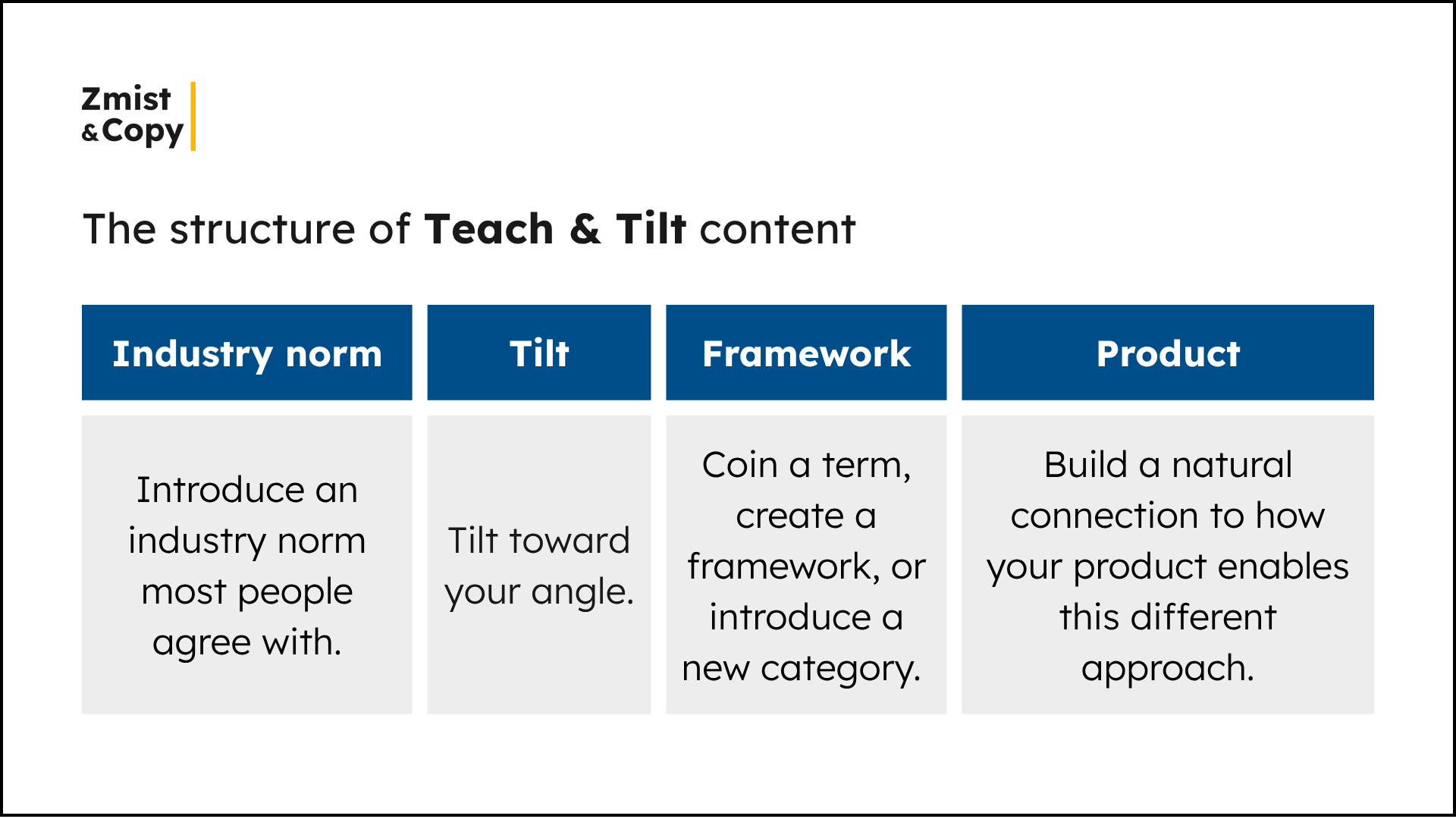
How the best companies use Teach & Tilt without knowing it
Teach & Tilt is a coined term for this way of thinking about educational content. But we didn't come up with it out of nothing. We just spotted some patterns found in the content we love. This content follows the Teach & Tilt structure. Here are a few examples.
1. Brendan Hufford's "Checkbox Marketing"
Brendan didn't write "What is a Marketing Strategy?" He coined the term "checkbox marketing" to describe the insidious trap of doing marketing activities without understanding why.
- Industry norm: Everyone knows marketing requires multiple activities.
- Tilt: Most teams do marketing activities like a checklist, without connecting them to outcomes or strategy.
- Framework: "Checkbox marketing" — a memorable term for this dysfunction.
- Product: This insight positions Brendan as someone who can help create a content strategy.
2. Animalz's "Bottom Line Up Front"
Animalz didn't write "How to Write Content Clearly." They introduced BLUF (Bottom Line Up Front). It's a military communications standard that challenges how businesses structure their writing.
- Industry norm: Everyone wants to read content written clearly.
- Tilt: Most business writing buries the important information, forcing readers to hunt for the main point that they want to make.
- Framework: BLUF: put the most important details first.
- Product: This framework positions Animalz as a content agency that understands how to make your writing clearer.
3. Grow and Convert's "Pain Point LLMO"
Instead of explaining what LLMO is, they argued that "product-centric, bottom-of-funnel content on your own site beats Reddit & PR" for pain point LLMO.
- Industry norm: LLMO is becoming important for visibility.
- Tilt: Most advice about LLMO is wrong. You don't need to chase Reddit mentions.
- Framework: Pain Point LLMO: focus on product-centric content on your own site.
- Product: This positions them as LLMO experts who understand what actually works.
7 structures for Teach & Tilt content
Structure 1: The myth buster: Myth: [Common belief]. Reality: [Your contrarian view]
Example:
Myth: More features = better user adoption. Reality: Users choose tools that solve one problem well, not platforms that overwhelm them with options.
Structure 2: The redefinition: Everyone calls it [common term]. We call it [your term]. Here's why.
Example:
Everyone calls it team chat. We call it digital HQ. Here's why the distinction matters.
Structure 3: The hidden problem: You think your problem is X. Your real problem is Y.
Example:
You think you have a lead generation problem. You actually have a content marketing system problem.
Structure 4: The framework flip: The [industry standard] framework everyone uses. And why we built something better.
Example:
The RICE prioritization framework product teams love. And why we created the ICE+ framework instead.
Structure 5: The counter-conventional: Why [best practice] is actually harmful (and what to do instead)
Example:
Why 'benefits over features' are killing your copy performance (and what actually matters)
Structure 6: The category creation: Introducing [new term], the missing piece in [established category]
Example:
Introducing The Context Engine, the missing piece in your organic growth strategy.
Structure 7: The assumption challenge: What if everything you know about [topic] is wrong?
Example:
What if everything you know about user onboarding is wrong? (A case for delayed activation)

How to choose your Teach & Tilt topics
Not every educational topic deserves the Teach & Tilt treatment. Here's how to pick those that do:
1. Start with your positioning. What do you do differently? Work backwards from your unique value proposition.
Questions to ask:
- What's our core differentiator that prospects don't immediately understand?
- What do we do that competitors claim is "wrong" or "unnecessary"?
- What aspect of our methodology challenges industry norms?
Example: If you claim "we build faster by doing less upfront planning," your Teach & Tilt topic might be "Why detailed project specs are killing your development velocity."
2. Find the debates in your industry. What does everyone in your industry accept as truth? What "best practices" do you disagree with? What's everyone getting wrong about the new thing?
Look for:
- Industry "best practices" that cause problems
- Conventional wisdom that worked 5 years ago but doesn't today
- Popular frameworks that miss critical elements
- Emerging trends where the mainstream advice is misguided
Example: If everyone preaches "mobile-first design" but you believe in "context-first design," that's your angle.
3. Audit your sales conversations. What misconceptions do prospects have? What do they need to unlearn before they can understand your approach?
Listen for:
- Objections that reveal fundamental misunderstandings
- Questions that show they're thinking about the problem wrong
- Assumptions they make that work against them
- Industry myths that make your solution seem unnecessary
Example: If prospects always ask "What's your domain authority and how many backlinks can you build?" but success depends on distinctive positioning and brand-building content, write "Why SEO agencies can't solve your content marketing problem."
4. Pick your winners. Make a list of "sacred cows" or conventional wisdoms and start prioritizing them.
Prioritize topics that:
- Directly support your positioning claims
- Address common prospect misconceptions
- Challenge widely-accepted but problematic practices
- Connect to business outcomes
- Have enough substance for a framework or methodology
Red flags to avoid:
- Topics where you're contrarian just to be different
- Debates that don't connect to your unique value
- Sacred cows that are sacred for good reasons
- Trends so new that your perspective isn't fully formed
Now, when you have nailed your top-of-the-funnel content, let’s move on to the next framework, one for middle-of-the-funnel.
Framework 2: See It Solved (MOFU) --> Instead of writing generic how-to guides, tell how YOU solve a problem
The problem: Jobs to be done content that doesn't show how the job was done.
The typical JTBD (or how-to) content looks like this:
"To build an app like Uber, you need: user authentication, GPS tracking, payment processing, real-time matching, push notifications..."
Cool. But HOW do you actually implement real-time matching? What APIs do you use? What problems will you encounter, and how do you solve them?
Most JTBD content provides a recipe but never shows what the company writing it has actually done. And when it does, that experience feels disconnected, like random case studies that don't support the point. They just say, “We did this, we did that” without proving anything.
That's a missed opportunity. Because the whole point of JTBD content should be demonstrating your capability to solve the job.
The solution: Show your product solving problems.
Instead of just identifying what needs to be done, See It Solved shows your solution in action, walking through scenarios and demonstrating your methodology.
The key difference:
❌ Common JTBD: "How to implement real-time notifications"
✅ See It Solved: "How TechFlow implemented real-time notifications that reduced user churn by 23%"
❌ Common JTBD: "How to optimize your sales funnel"
✅ See It Solved: "How we optimized FinanceApp's sales funnel and doubled their trial-to-paid conversion"
❌ Common JTBD: "How to build a mobile app"
✅ See It Solved: "How we helped X build their mobile app in 12 weeks (and what we learned)"
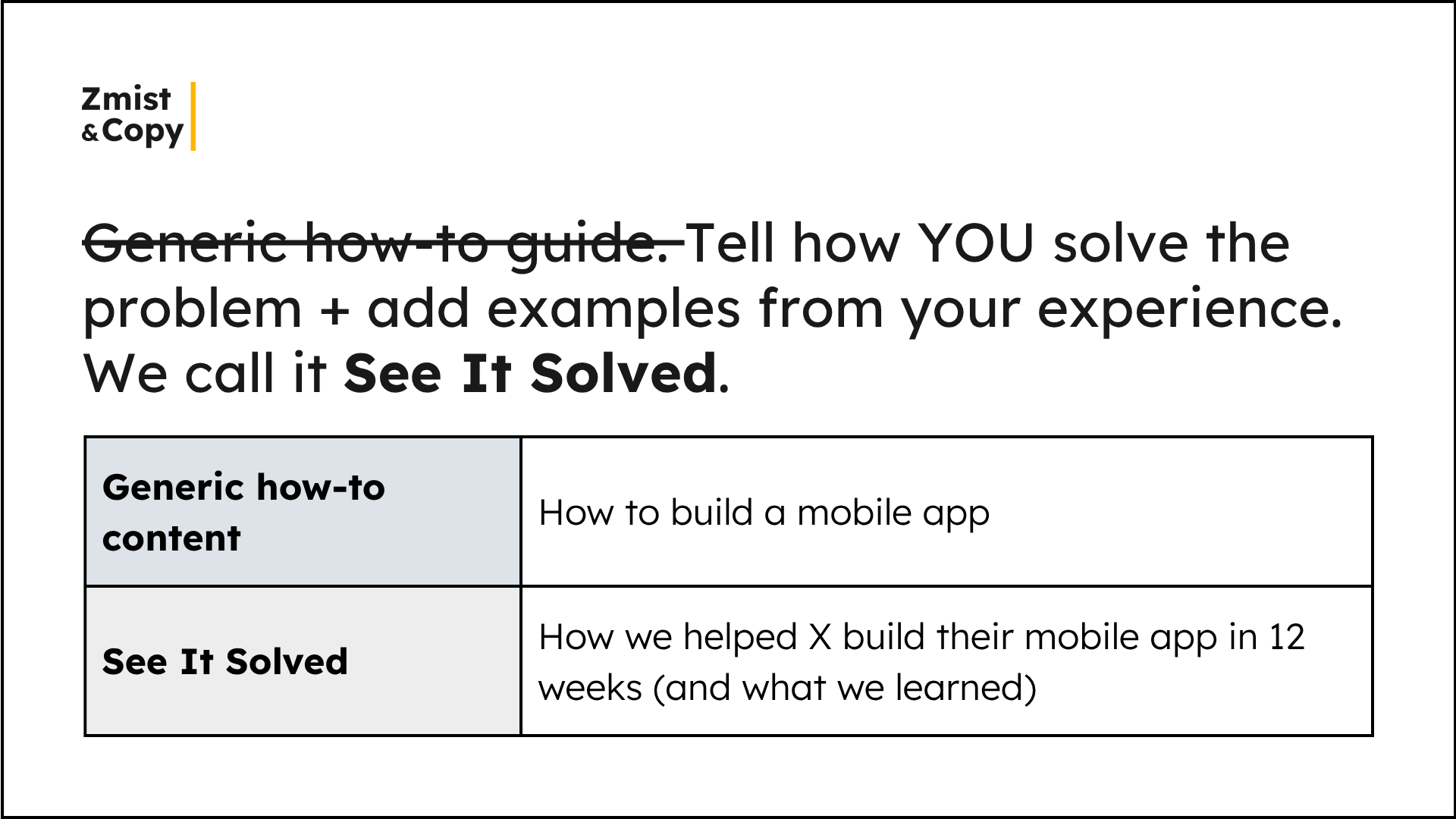
See It Solved content always includes a story and specific results.
The structure: Problem → Plan → Proof → Product → Playbook
Step 1: Problem. Make it specific enough that your target audience thinks, "Yes, that's exactly what I'm dealing with."
❌ Generic: "Content marketing challenges"
✅ Specific: "You've been publishing blog posts for 8 months, but you're still not getting any leads from organic traffic"
Step 2: Plan. Walk through your specific approach. Not a generic process, tell them how YOU solve this particular problem.
Example: "Here's our 3-step content audit process:
- Identify which pages lose people right before a key action.
- Find what’s missing: clarity, proof, link to the next step.
- Adjust content to keep the reader moving to the next step."
Step 3: Proof. Show your plan work with an example. Use specific numbers and outcomes.
Example: "When B2B software company TechFlow came to us, they'd been blogging for 10 months with zero leads. After implementing our content audit process, we discovered they had zero bottom-funnel content. Within 90 days of publishing 8 new comparison pieces, they went from 0 to 23 qualified leads per month."
Step 4: Product (connect naturally to your solution). Show how your product or service makes the solution possible.
Example: "The reason we could identify those content gaps so quickly was our proprietary content mapping framework, which connects each piece of content to specific buyer psychology patterns."
Step 5: Playbook. Provide something actionable they can use right now. This serves two purposes: immediate value and lead generation.
Example: "Want to audit your own content? Download our 'Content-to-Conversion Mapper.' It's the same spreadsheet we used with TechFlow."

Example of See It Solved content
HubSpot didn't write "How to Improve SEO Performance." They wrote "HubSpot's SERP Secrets: How The HubSpot Blog Is Combatting SERP Volatility."
- Problem: Organic traffic crashed after Google's M23 update
- Plan: EEAT framework with "Experience Soup" recipe
- Proof: Mini-case with specific results - +251% signups, +26% CVR on the website builders post
- Product: Shows HubSpot's expertise and positions their content approach
- Playbook: Gives readers the framework to replicate (Experience Soup recipe)
5 formats for See It Solved content
1. Client transformation: How [client] went from [problem] to [outcome] using [your approach]
Best for: Demonstrating before/after transformations.
Example: "How Finance App Doubled Trial Conversions by Fixing Their Onboarding Flow"
Template:
- Problem: [Client] was struggling with [specific challenge]
- Approach: We implemented our [methodology] which includes [specific steps]
- Results: Within [timeframe], they achieved [specific outcomes]
- How we did it: [Detailed explanation of your process]
- What you can do: [Actionable steps readers can take]
2. Internal case study: How we [achieved result] by [doing specific thing] (and what we learned)
Best for: When you can't share client details but want to demonstrate capabilities.
Example: "How We Sped Up Delivery by 40% with AI (Our 4-Pillar Framework)"
Template:
- Challenge: We were facing [internal problem]
- Hypothesis: We believed [approach] would help because [reasoning]
- Experiment: Here's exactly what we tried [detailed process]
- Results: We achieved [specific outcomes] in [timeframe]
- Learnings: What worked, what didn't, and what we'd do differently
3. Methodology reveal: The [your framework] that [achieves specific outcome]
Best for: Showcasing proprietary processes or frameworks.
Example: "The Content Velocity Framework That Helped 3 Clients Triple Their Publishing Speed"
Template:
- Problem: Most companies struggle with [specific challenge]
- Why existing solutions fail: [Common approaches] don't work because [reasons]
- Our approach: The [Framework Name] solves this by [core principles]
- Case example: How [Company/Scenario] used this framework to [specific result]
- Implementation guide: How to apply this framework in your organization
4. Technical deep-dive: How to [achieve technical outcome] (with implementation details)
Best for: Technical audiences who want to see actual solutions.
Example: "How to Implement Real-Time Analytics That Scale to 100K+ Users"
Template:
- Technical challenge: The specific technical problem you're solving
- Architecture overview: High-level approach and technology choices
- Implementation details: Code examples, configurations
- Example: How this worked for a specific client or project
- Performance results: Specific metrics and outcomes
5. Comparative analysis: Why we chose [Approach A] over [Approach B] (and the results)
Best for: Positioning your methodology against alternatives
Example: "Why We Built Custom AI Agent Instead of Using n8n (And How It Improved Scalability)"
Template:
- Choice: We had to decide between [Option A] and [Option B]
- Evaluation criteria: Here's how we evaluated each option
- Our decision: We chose [Option] because [specific reasons]
- Implementation: How we executed this choice
- Results: Specific outcomes and why this choice was right
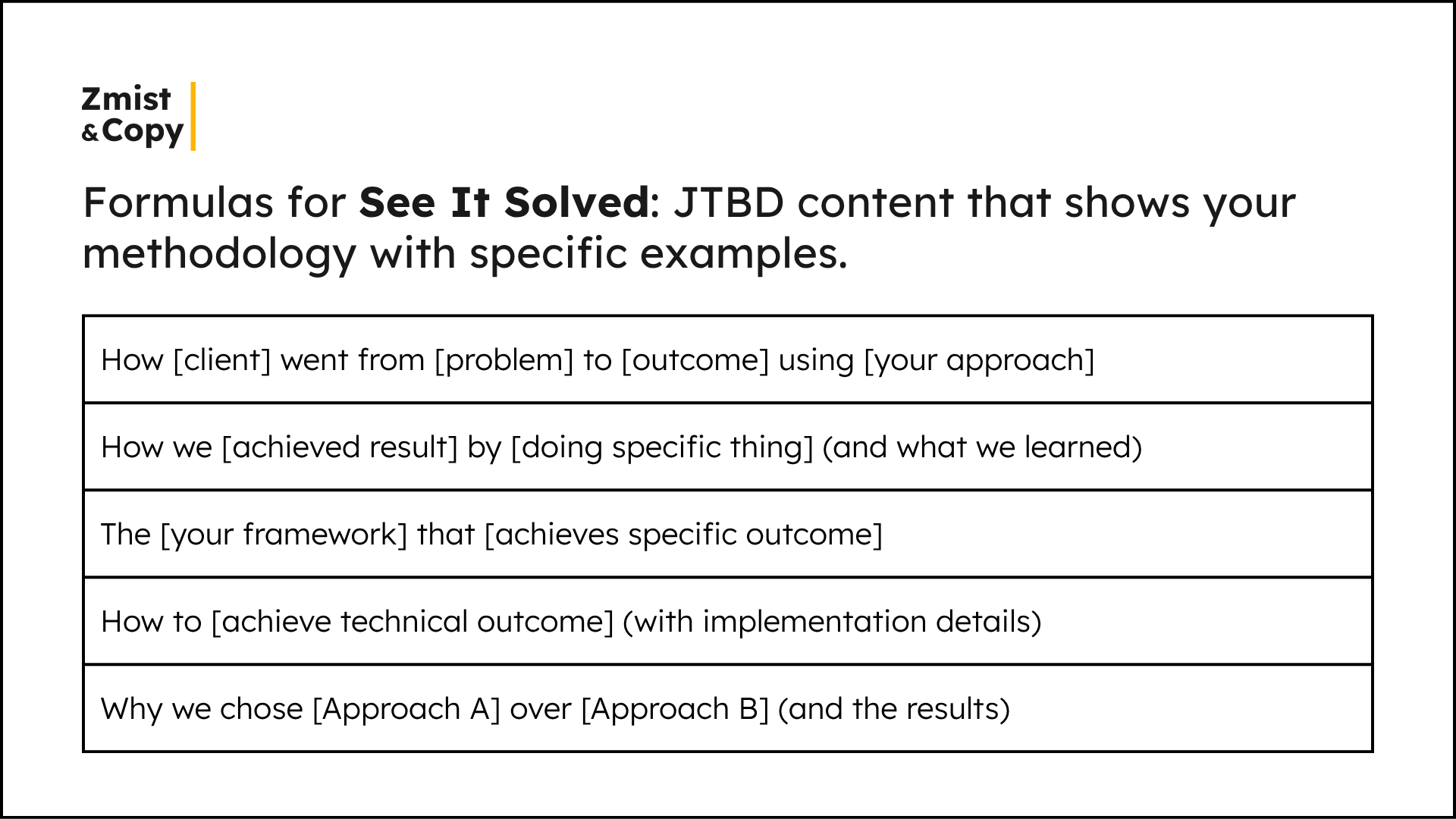
Common mistakes (and how to avoid them)
Mistake 1: Being too vague about the problem
❌ Content marketing challenges
✅ You've published 50 blog posts but only generated 3 sales qualified leads
Mistake 2: Sharing process without proof
❌ Our 5-step methodology for improving conversion rates
✅ How our 5-step methodology helped Client X improve conversion rates by 40%
Mistake 3: Making the product connection too salesy
❌ Our platform is the best solution for this problem
✅ This is why companies with this challenge often turn to solutions like ours
Mistake 4: Forgetting the playbook
❌ Don't leave readers thinking "This sounds great, but how do I actually start?"
✅ Always include something they can download and use immediately.
Framework 3: Results-Forward (BOFU) case studies --> Instead of work samples, write customer success stories with outcomes
The problem: case studies that read like work samples.
I've read hundreds of case studies. Some are painfully vague, with titles like this: "Digital Transformation Solution: How Enterprise Client Leveraged Innovative Solutions for Stakeholder Alignment"
Others are too insignificant and look like this: "Cloud-based LMS for corporate learning”
In the first case, companies believe that the vaguer the story, the more “mature” they’ll sound.
In the second case, they’re just writing work samples that show what they can do, but do not show why they’re the right company to solve the problem.
The solution: Lead with outcomes, prove your positioning claims
Instead of burying the outcome in the "results" section or not talking about it at all, you lead with it. This way of writing case studies doesn't only show you can solve problems and deliver results. It also forces you to think about how to prove your positioning claims.
The difference is obvious:
❌ Common case study: "Digital Transformation Journey: How Enterprise Client Modernized Operations"
✅ Results-Forward: "Logistics Company Cuts Delivery Costs by 30% with Route Optimization Algorithm"
❌ Common case study: "Comprehensive Platform for Customer Support"
✅ Results-Forward: "CSM Scales from 100 to 10K Users Without Adding Support Staff"
❌ Common case study: "AI Powered Security Tool"
✅ Results-Forward: "Fintech Startup Adopts AI and Reduces Compliance Costs by 60%"
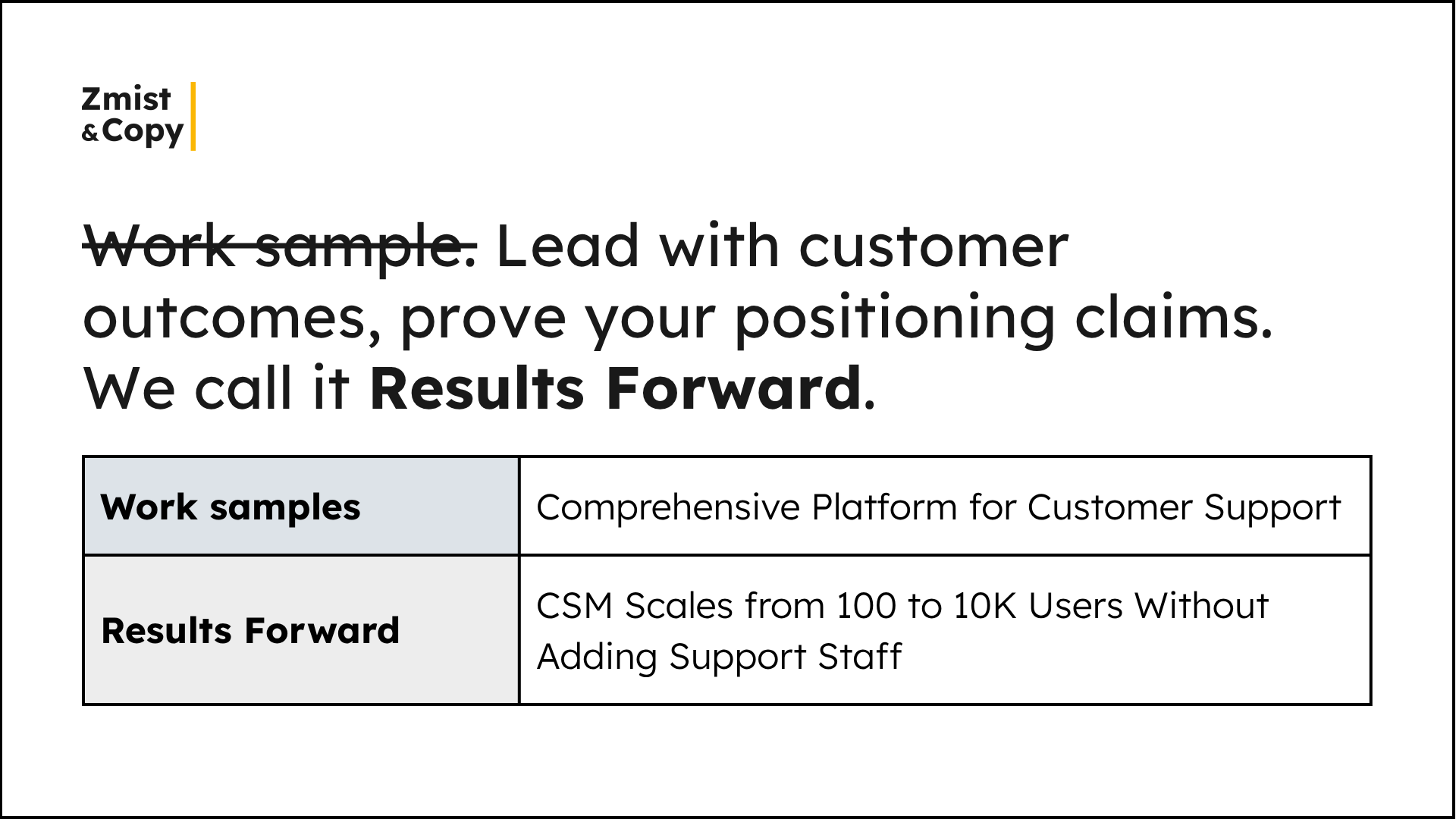
The structure: Result → Story → Methodology → Impact
Step 1: Result. Your headline does 80% of the work. It needs to be specific.
Formula: [Customer type] [achieves specific outcome] [using your approach/in timeframe]
Examples:
- E-commerce Platform Increases Conversion Rates by 35% with Personalized Checkout Flow
- SaaS Startup Scales to 50K Users in 8 Months with Custom Infrastructure
- Manufacturing Company Reduces Quality Defects by 80% with AI
Step 2: Story. Set up the situation. What was the client trying to achieve? Why was it crucial? What would happen if they failed?
Example: "TechFlow, a B2B software company, has been publishing blog content for 10 months but generated zero sales qualified leads. Their content marketing budget was about to get cut, and the marketing team needed to prove ROI or prepare for lay-offs."
Step 3: Methodology. Walk through your specific approach. How you solved this particular client's problem.
Example: "We implemented our Content-to-Conversion audit process: mapped their existing content to buyer journey stages, identified gaps in bottom-funnel content, and prioritized new pieces based on search volume and buying intent signals."
Step 4: Impact. Share the results. Include numbers, timeframes, and ongoing impact where possible.
Example:
- SQL in 90 days → TechFlow went from 0 to 10 qualified leads
- 20% marketing budget increase → After seeing the ROI, leadership decided to invest more in content marketing
- Team safe → The marketing team kept their jobs and gained more influence inside the company

Examples of Results-Forward case studies from our work
A case study we wrote for logistics and transportation software development company:
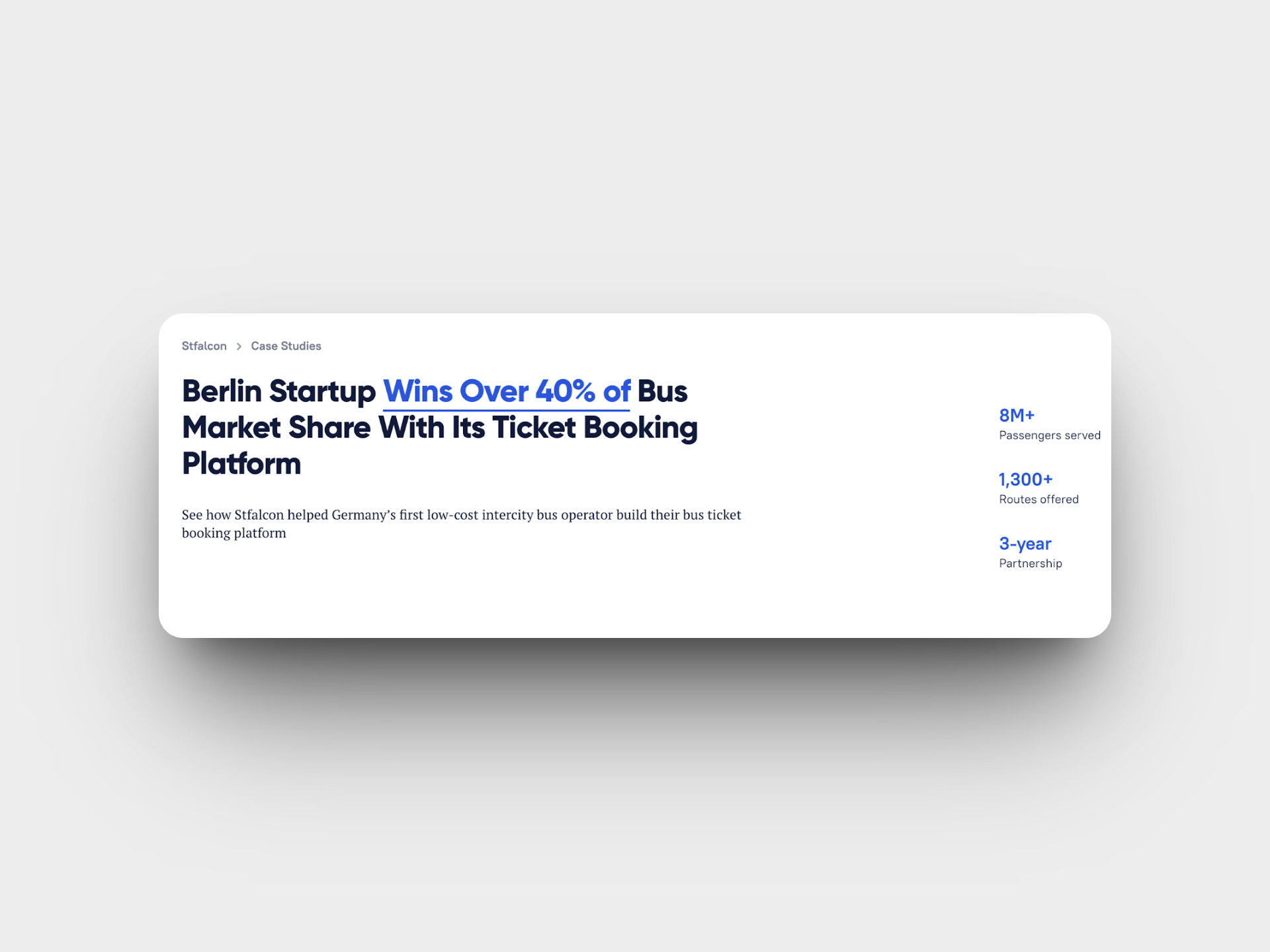
A case study we wrote for a software development company, trusted by VC-backed startups to scale their engineering teams:

A case study we wrote for a consulting company that helps technology businesses grow faster:

5 case study formats
1. The speed story
Best for: Time-sensitive claims
Structure: [Customer] achieves [outcome] in [short timeframe]
Example: "Startup Launches MVP in 6 Weeks Using Low-Code Platform"
Template:
- Why speed was critical for this client
- How you accelerated the typical process
- Immediate results achieved
2. The efficiency story
Best for: Cost savings or resource optimization claims
Structure: [Customer] [reduces cost/saves time] by [percentage] with [your solution]
Example: "Manufacturing Plant Cuts Energy Costs by 40% with Smart Monitoring System"
Template:
- The specific inefficiency costing them money
- Your approach to finding and eliminating waste
- Cost reductions and efficiency gains
3. The performance story
Best for: Technical performance claims
Structure: [Customer] achieves [specific performance metric] with [your solution]
Example: "SaaS Platform Scales from 1K to 100K Daily Users Without Performance Issues"
Template:
- What was limiting their ability to scale
- How your solution handles growth
- Specific technical improvements achieved
- How technical scaling enabled business growth
4. The growth story
Best for: Business impact claims
Structure: [Customer] scales from [starting point] to [end point] with [your solution]
Example: "Healthcare Company Launches Health App, Gains 5K Leads in Beta Testing Stage"
Template:
- Growth challenges faced
- Your approach to solving these challenges
- Growth metrics achieved
5: The transformation story
Best for: Complex projects with multiple wins
Structure: [Company] and [Partner] team up on [scope] to [transformation outcome]
Example: "Five Nights At Freddy's: Pingle and Steel Wool Studios Team Up on 12 Projects to Expand the Legendary Franchise""
Template:
- Before state in the client's business
- How you guided them through change
- Different achievements over time
- Continued success and expansion
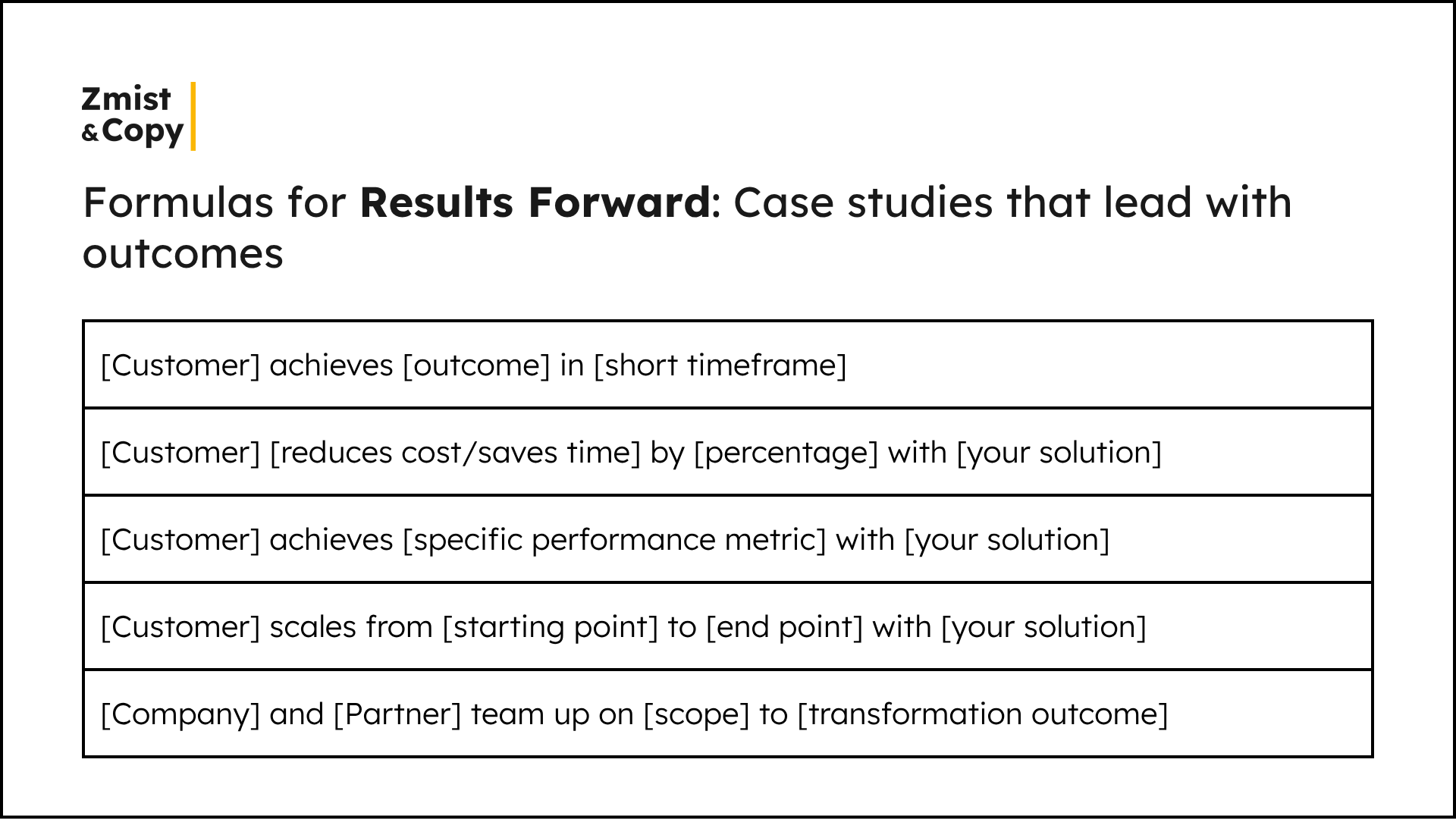
How to make your case studies AI-citation worthy
AI tools cite case studies when prospects ask questions like:
- Can you show me examples of companies that succeeded with [solution]?
- What results have other companies achieved with [approach]?
- Are there case studies showing [specific outcome]?
To get cited, your case studies need:
- Specific outcomes. Bad: "improved efficiency." Good: "reduced processing time by 60%."
- Industry context “Healthcare startup deliverying virtual primary care" is better than "technology company."
- Timeframes "in 3 months" is more citable than "fast."
- Comparison points "50% more affordable than previous solution" gives AI tools context for recommendations.
- Quotable insights. Include client quotes that add credibility to your claims.
How to choose which stories to tell
Instead of picking your favorite project and hoping it supports your positioning, you should identify the claims you're making and find the stories that prove them. How you can approach this:
Step 1: Audit your positioning claims. What promises do you make on your homepage?
Step 2: Match stories to claims. For each positioning claim, identify which client stories best prove that claim.
Step 3: Prioritize by impact. Choose stories with the most dramatic results from recognizable companies.
Step 4: Fill the gaps. If you don't have case studies to prove a key claim, create that proof.
How to Zmistify your content
The Context Engine transforms your content from generic to distinctive by prioritizing trust-building over traffic-building, and getting both.
Teach & Tilt establishes your unique perspective.
See It Solved demonstrates your way of solving specific customer problems.
Results-Forward provides the proof that closes deals.
Together, these three frameworks create a content funnel that builds brand authority and gets you cited by AI tools as the go-to expert in your space.
Here is why The Context Engine works in the AI era
1. You build positioning, not just pages.
Instead of chasing keyword variations, you clarify what makes you different, and who needs you. Our frameworks force that clarity. When AI tools look for the right solution within a specific context, they reference your brand.
2. Your content becomes citation-worthy by design.
Our frameworks help you create memorable concepts and perspectives. This is the kind of content that gets referenced naturally across the web. That means you can earn mentions and backlinks organically.
3. You move from volume to authority.
Instead of producing endless low-quality articles, our three models help you consolidate your expertise, go deep, and become the recognized authority. When AI searches for sources on your topic, it finds a body of work that signals expertise and builds the kind of trust that shallow SEO posts never would.
The Context Engine implementation roadmap
Step 1: Audit your content
Before you create new content, you need to understand what you already have and where the gaps are. Here's how to audit your existing content through the Context Engine lens.
Pull up your blog, case studies, and key landing pages. For each piece, ask three questions:
Teach & Tilt check:
- Does this challenge conventional wisdom or just repeat industry talking points?
- Could someone quote a specific insight or framework from this?
See It Solved check:
- Does this show our methodology in action?
- Could a prospect understand how we solve problems from reading this?
- Is there a specific client story, or is this all hypothetical?
Results-Forward check:
- Does the headline lead with the outcome or bury it in paragraph five?
- Does this prove one of our positioning claims?
Step 2: Map content to your positioning claims
Now look at your homepage or positioning statement. What specific claims do you make?
Examples:
- We deliver enterprise projects 40% faster than other agencies
- We specialize in healthcare compliance software
- Our approach reduces technical debt while shipping features
For each claim, ask:
- Do we have Teach & Tilt content explaining why our approach is different? If you claim speed, do you have content challenging the opposite approach?
- Do we have See It Solved content demonstrating how we deliver this? If you claim healthcare expertise, do you show your compliance process in action?
- Do we have Results-Forward case studies proving this claim? If you claim 40% faster delivery, do you have headlines like "Healthtech Company Launches HIPAA-Compliant Platform in 12 Weeks"?
Step 3: Identify funnel gaps
Map what you have to the buyer's journey:
Top of funnel (Awareness)
- Can prospects discover your unique perspective?
- Do they understand why other approaches fail?
Middle of funnel (Consideration)
- Do prospects see your methodology in action?
- Can they visualize working with you?
Bottom of funnel (Decision)
- Do prospects have evidence you deliver on claims?
- Can they justify choosing you over alternatives?
Step 4: Prioritize which model to start with
Don't fix everything at once. Choose based on your constraint:
Start with Results-Forward if you have case studies but they don't convert.
Start with Teach & Tilt if prospects don't understand your positioning.
Start with See It Solved if your methodology is complex or counterintuitive or sales needs better enablement content.
The principle: Quality over quantity. One excellent Teach & Tilt piece beats ten generic blogs. One Results-Forward case study that proves positioning beats five boring work samples.
Start small. Go deep. Build authority, not volume.
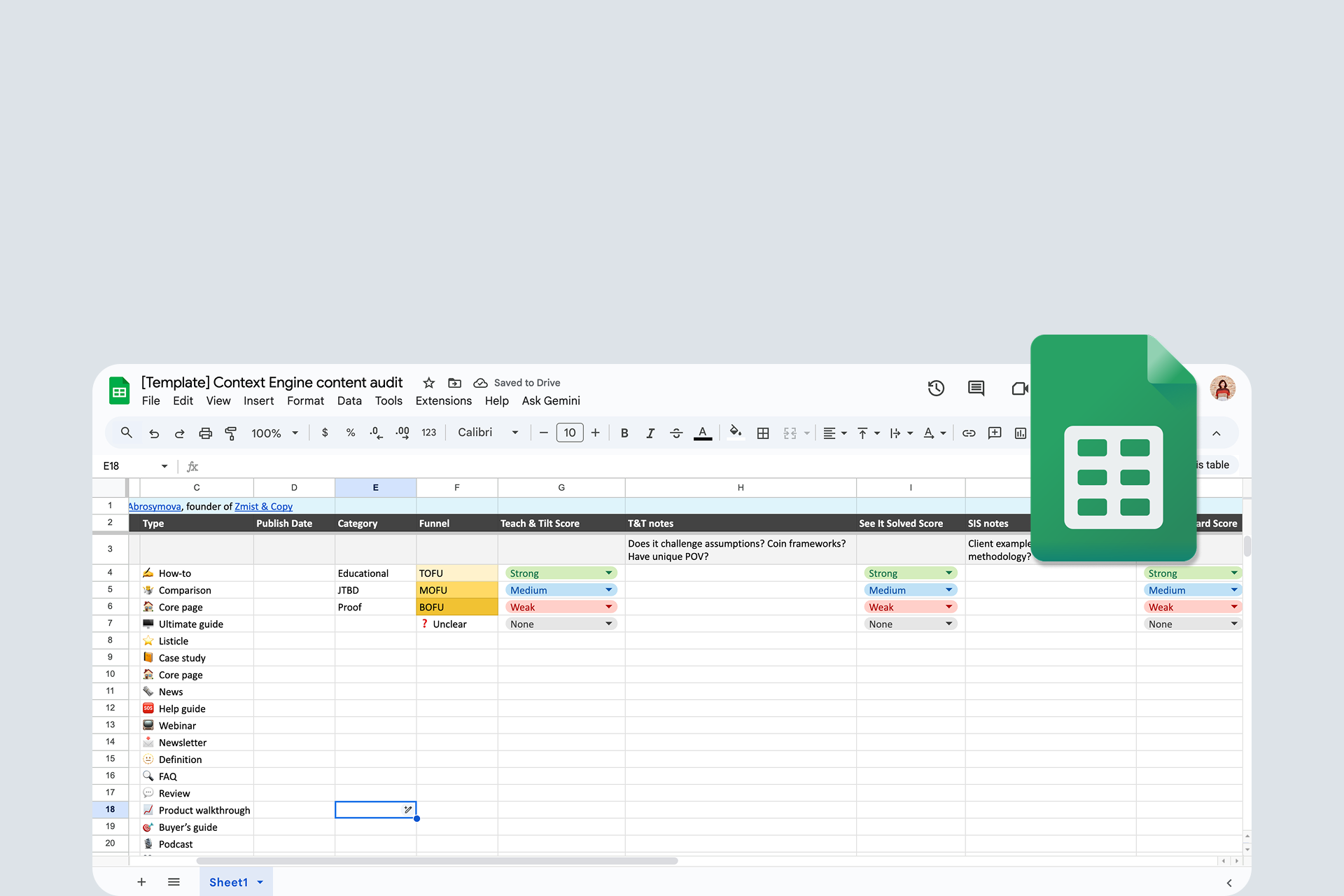
Grab a template for auditing your content against our framework.
Don't forget about distribution
Creating great Context Engine content is half the battle. Getting it seen is the other half.
You need to build a consistent narrative not only on your website, but everywhere else. Your goal is to build a web of citations across trusted sources that all reinforce your positioning and make your value prop appear repeatedly.
Here's how:
- YouTube videos - Turn your Context Engine into 10-20 minutes explainer videos.
- LinkedIn posts - Continually share your unique perspectives on LinkedIn.
- Newsletter - Share the Context Engine content with your list and keep weaving your perspectives, methodology, and proof into future newsletters. It should become a consistent thread throughout all your content.
- Reddit/Quora answers - When someone asks about the topic, reference your framework and approach. Don't spam, add value.
- X thread - Share the problem → solution → outcome as a story thread.
- Webinar - Turn your approach into a deep-dive with Q&A.
- Sales collateral - Create one-pagers for your sales team to share during calls.
- Contribute guest posts to industry publications.
- Get quoted by journalists - Use platforms like Qwoted. When journalists ask for expert opinions, respond with your unique take.
- Record your talks on industry events and publish them on YouTube - Every conference video is another place AI can find your expertise.
- Co-create content with companies that serve the same audience - Get mentioned in their newsletters, podcasts, and blogs.
- Write your own comparison posts - Create "Best X for Y" content that includes you and competitors. Be fair. Add value.
- Pitch to be included in other listicles. Find popular "Best X for Y" posts that don't mention you. Email the author with a one-paragraph description, your differentiation, and a screenshot.
Track brand mentions and AI citations:
- Are you being mentioned at all? If not, you need more distribution.
- Are you mentioned in the right context? If AI describes you wrong, your positioning isn't clear.
- Are competitors mentioned more? Study what they're doing differently.
- Which URLs get cited? Double down on those.
Here is a short Lovable version of The Context Engine implementation roadmap.
That's it!
Have questions? DM me on LinkedIn.
PS: Want our help zmistifying your content? Send us an email, and let's book a call.

